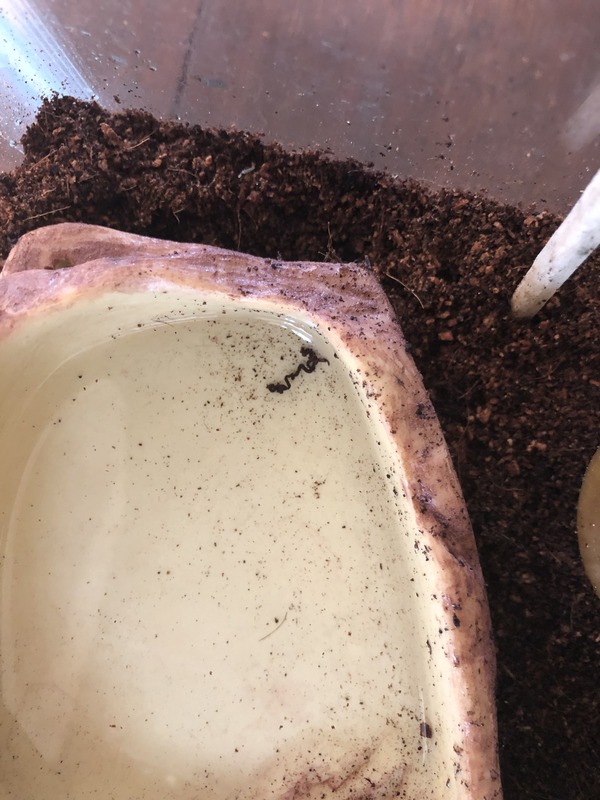I remember when I first got my hermit crabs. After a few days after buying them I started to wonder, do they poop?
So, I did some research. Hermit crabs, like all animals, defecate. It looks like tiny, brown logs that tend to scatter the tank’s bedding. You’ll most likely find their droppings nearby their water or where they tend to hide.
Like myself, most hermit crab owners are uneducated about hermit crabs and their behavior. Let’s go over everything you need to know about hermit crab poop, pee, and how to it all up.
What does hermit crab poop look like?
If you have coconut substrate like I do, it can be really hard to spot hermit crab poop. Lucky for you, one of my crabs left a unmistakeable blob of hermit crab poop in their saltwater bowl. They were probably using the saltwater to wash out their shell, which is the whole point of a saltwater bowl.

Hermit crab poop is a black or very dark brown squiggly strand. It looks like a thick, curly hair. This is because it bunches up in the back of a hermit crab’s shell, and falls out when a hermit crab decides to clean out its shell.
Hermit Crab Defecation
Hermit crabs defecate through their anus, which is found at the very end of their tail. If you have ever seen a hermit crab before, their tail is usually safely tucked away in their shell.
Being that is where their anus is, their poop subsequently stays in their shell as they go about living their crabby life. They don’t mind going to the bathroom where they sleep, it’s only their natural instinct.
In the wild, hermit crabs cannot leave their shell to their business. They would most likely get scooped up by a seagull or other predator. So, they resort to doing their business in their shell.
You might think it’s unsanitary, and it is. Eventually, the crab will scrape the poop drops out of its shell with their abdomen as they crawl around the tank or take a swim.
If you don’t have a dark brown substrate, which makes born hermit crab poop blend in, you’ll eventually see a few droppings layn across your tank.
I call them “logs” because they tend to lay flat across the bedding, without piling up in beehive shapes like other pets such as cats and dogs.
I think this is because hermit crabs intentionally do not crawl over already scattered poop. If they avoid spots with poop already, the new poop in their shells will fall on their own in different areas.
They’re no larger than a penny and as thin as a blade of grass. They’re more noticeable if you have a more brightly-colored substrate.
Well, needless to say, this makes for a nasty hermit crab tank. Let’s talk about cleaning up after your hermit crabs.
Cleaning Hermit Crab Poop
I love my hermit crabs, but they are very messy. I consider myself a messy person but at least I don’t leave my poop lying around!
There are 4 things we can do to keep our hermit crab’s environment free of poop:
- Go spot-cleaning for hermit crab waste once a week.
- Add swimming pools.
- Clean the empty shells.
- Replace your tank’s substrate.
Spot Cleaning
The best way to keep your tank void of any hermit crab poop is to scoop them out yourself.
If you have brown-colored bedding, this will be a tedious chore. The dime-sized feces will blend right in.
The best place to look is nearby the tank’s water pools. The little turds that accumulate in the crab’s shells like to fall out once they go for a swim.
When you see a “log”, either scoop it up with your fingers or a small spoon and throw it away. It’s usually firm and stays together in your hand unless it’s floating in your water bowl. If so, replace the water so that your hermit crabs can swim in clean water.
A cool trick to clean out any stray hermit crab droppings is to use a kitchen strainer or aquarium fishnet to strain your tank’s sand to remove any poop. If you use Eco Earth like me, this sadly won’t be an option.
If you do this once every week or so, your hermit crab tank will stay clean and poop-free. I keep a calendar above my hermit crab tank to stay consistent and on schedule.
Swimming Pools
The best way to encourage our crabs to stay clean is to add two bowls of water to your hermit crab tank. One needs to be filled with dechlorinated fresh water, the other with salt water.
If you don’t have these pools installed already, I highly recommend that you do so. They are imperative for your crab’s health.
The two swimming pools will allow your hermit crabs to drink and take baths whenever they want to clean out their nasty shells.
Cleaning the empty shells
Often times I will see a crab take a risk and move from its shell to one of the vacant ones that line my tank to do its business. From there it will either claim that shell as its own, leaving its old one behind, or go back in its shell.
It’s pretty amusing to see but requires more work on your part. To keep your tank clean and not as smelly, you should clean your extra shells of any hermit crab feces every few weeks.
You can shake them out over a trash can and clean out the poop just fine. To more thoroughly clean the shells, try boiling them.
Plopping them in boiling water for 5 minutes or so will do the trick. You’ll see any dirt, poop, or other remnants from the tank float to the surface leaving the clean shell at the bottom. Just make sure you thoroughly check the insides of your shells to make sure none of your hermit crabs are inside!
Replacing the substrate
You should replace the substrate of your hermit crab tanks every 3 months, or as needed. I find a nice mixture of play sand and Eco Earth (ground coconut husk) do a great job at keeping humidity.
I use mainly Eco Earth, which is completely fine. Eco Earth is great for dealing with poop because it does a great job breaking it down. The only issue is that it’s hard to spot crab poop since they blend in with the coconut husk.
Play sand, another popular substrate, isn’t as effective toward breaking down feces, but make it much easier to spot clean.
Replacing the substrate will take a few hours time, so plan ahead. You’ll need to move your hermit crabs to a new spot for a bit as you do your work.
Empty the old substrate outside and spray the inside of your tank with a hose. This will remove the old substrate and make room for the new one.
Meanwhile, boil any shells left in your tank for 5ish minutes and leave all decorations out in the sun.
Once you’ve completed all that, simply re-setup your hermit crab tank with everything your little crabs need.
Now the tank will be free of poop, and your hermit crabs will be thrilled with their clean environment.
Without a proper way for your hermit crabs to clean themselves, the buildup of feces in their shell and environment can lead to sickness or death. Be sure to add well-functioning pools in your hermit crab enclosure to keep them healthy.
Related Questions
Do Hermit Crabs Pee?
Of course, hermit crabs pee. Their bladder is not near their anus, that would be ineffective because most land hermit crabs store water in their shells. The last thing they want is for their pee to get mixed with their drinking water.
A hermit crab pees from its urinary bladders located at the base of each antennule [the smaller ones just beside the eyes]. The amount it pees, however, is very minuscule, so you most likely will not notice it.
Imagine having to pee from your face! Yuck!
Do hermit crabs smell?
As long as hermit crabs are kept in a healthy, clean environment you won’t smell a thing. The only time they do give off a stench is when they molt. The chemicals used in the molting process gives off a rotten medicine stench, which goes away as they dig.
